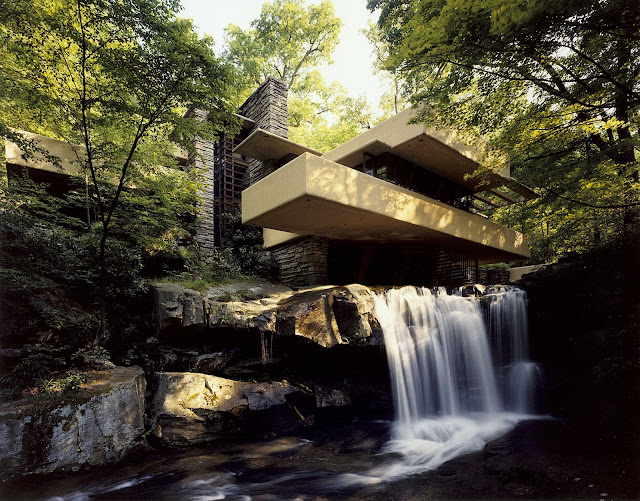View Fallingwater in a larger map
Visit our Tour Destination:
 |
| Fallingwater. Photo courtesy of Western Pennsylvania Conservancy. |
Fallingwater
Mill Run, PA
Website: Fallingwater
The Treasure: A
Frank Lloyd Wright masterpiece, Fallingwater is his iconic house
on the waterfall—a sublime embodiment of Wright’s belief in “organic
architecture.”
Accessibility: Advance ticket purchase is essential for all tours at Fallingwater. From April through
November, the site is open daily (except Wednesday). Check the website for
limited hours in March and December. The house is closed for tours in January
and February, although Grounds Passes may be available, weather permitting.
 |
| First view of Fallingwater from the trail. Photo by Lisa Price, courtesy of Western Pennsylvania Conservancy. |
Background: Fallingwater
is nestled deep within a tranquil Appalachian oak forest . The beauty of the wilderness is
enhanced by the Bear Run stream that cascades over ledges of Pottsville sandstone, creating picturesque
waterfalls. As you approach, you can hear the falling water before you see the
house. Fallingwater is a multi-sensory experience.
The wealthy owner of Kaufmann’s Department Store in Pittsburgh , Edgar Kaufmann (1885-1955) and his wife Liliane
(1889-1952) were attracted to this rustic getaway, located in the mountains
southeast of Pittsburgh ,
for its beauty and cool mountain air. In 1916, they altruistically fashioned
the property as a weekend retreat, first offering it to their female employees
and later extending the invitation to the men as well. At the Kaufmann’s summer
camp, the air was clean, the pace was relaxed, and there were opportunities for
hiking, swimming, fishing, and horseback riding.
In the 1930s, with the Great Depression severely decreasing
use of the retreat by his employees, Kaufmann began to consider other uses for
the property. Dedicated to early principles of land conservation, he was
committed to keeping the primal Appalachian splendor of the land intact. But he
was open to new aesthetic ideas, too. His son, Edgar Kaufmann jr., introduced
his father to architect Frank Lloyd Wright’s revolutionary ideas. Wright’s
concept of “organic architecture,” harnessing local materials to create modern
buildings in harmony with the natural landscape, deeply appealed to Kaufmann. In
1934, he commissioned Wright to build his family a weekend vacation house showcasing
the view of a particularly beautiful thirty-foot waterfall.
Kaufman pictured his new house facing the waterfall, so Wright’s
proposal came as a surprise: he placed the house immediately above the falls, with
decks cantilevered from a rock ledge and the stream’s water perpetually falling
underneath the residence. In Wright’s vision, the house wouldn’t be a place for
viewing a beautiful scene—it would be an essential new component of the
beautiful scene. To their credit, the Kaufmanns thoughtfully considered and
then embraced Wright’s approach. Both in its interior and its exterior, Fallingwater was
conceived as a part of its environment.
When the main house was completed in 1937, Fallingwater was swiftly
promoted to fame by a January 1938 Time
cover story. Then 70 years old, Wright capitalized on his renewed fame with
vigor and imagination—there were more astonishing masterpieces in him,
including New York City ’s famous Guggenheim Museum
Reflecting on his work at Fallingwater,
Wright later said:
“Fallingwater is a great blessing—one
of the great blessings to be experienced here on earth. I think nothing yet
ever equaled the coordination, sympathetic expression of the great principle of
repose where forest and steam and rock and all the elements of structure are
combined so quietly that really you listen not to any noise whatsoever although
the music of the stream is there. But you listen to Fallingwater the way you
listen to the quiet of the country…”
Frank
Lloyd Wright
Talk
to the Taliesin Fellowship
May
1, 1955
 |
| Interior view of the Hatch looking toward the west terrace. Photo by Robert P. Ruschak, courtesy of Western Pennsylvania Conservancy. |
Notes from the
Editor: Fallingwater was the grand conclusion
of my family’s Chicago
vacation a couple of years ago. First, we visited the Frank Lloyd Wright Home
and Studio in Oak Park
and enjoyed their walking tour of Wright-designed buildings in the area, including Unity Temple. Then on
our trip back to New Jersey ,
we spent a lovely day at Fallingwater.
 |
| The editor at Fallingwater. Photo by Lisa Price, courtesy of Western Pennsylvania Conservancy. |
Other Recommended
Sites: There’s another acclaimed Frank Lloyd Wright building
less than seven miles from Fallingwater. One of the last residential homes to
be completed by Wright, Kentuck Knob complements Wright’s earlier work at
Fallingwater. Perched near the summit of a 2,050-foot mountain, it simultaneously
celebrates and blends into the landscape of Pennsylvania ’s
beautiful Laurel Highlands
 |
| View of the living room at Fallingwater, looking south. Photo by Robert P. Ruschak, courtesy of Western Pennsylvania Conservancy. |
Tour America's History Itinerary
Thursday: Johnstown Flood National Memorial
© 2013 Lee Price









